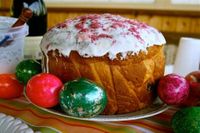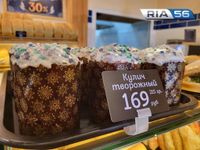As Orthodox Christians prepare to celebrate Easter on April 20, 2025, the focus is on the traditional Easter cake, known as "kulich." This festive treat is a staple of the holiday feast, marking the beginning of the Easter meal.
In Moscow, the variety of kulich available ranges from homemade delights to ready-made options found in stores, catering to different tastes and preferences. Prices for these cakes can vary significantly based on factors such as weight, ingredients, and the manufacturer. An online store offers kulich starting at just 99 rubles, while prices on popular marketplaces can range from 50 to 1024 rubles, reflecting the diverse choices available.
For those looking to purchase kulich, retail chains have also expanded their offerings online, providing convenient home delivery options. The prices for these beloved Easter cakes typically range from 287 to 810 rubles, making it accessible for many families to partake in this cherished tradition.
In Orenburg, the price of kulich varies by size. A small 100-gram kulich can be found for as little as 90 rubles, while medium-sized cakes weighing between 200 to 400 grams are priced from 170 to 250 rubles. For larger cakes, which weigh over 500 grams, prices start at 220 rubles and can reach up to 1000 rubles, depending on the bakery and ingredients used.
Meanwhile, in the Krasnodar region, the average cost of kulich has seen a notable increase, rising nearly 17% compared to last year. According to the Southern Main Branch of the Bank of Russia, a classic holiday kulich weighing 1.1 kilograms now costs approximately 272.7 rubles. The ingredients for this traditional cake include 250 grams of milk, 500 grams of flour, 100 grams of butter, 150 grams of sugar, three chicken eggs, 1.5 grams of salt, and 125 grams of dried fruits.
This price hike has been largely attributed to the rising costs of key ingredients, particularly butter, which has seen significant increases in recent months. Additionally, the price of curd Easter cakes has surged by 19.9% to 467.3 rubles for a 0.9-kilogram product, highlighting the broader trend of inflation affecting food items across the region.
Interestingly, not all variations of kulich have increased in price. Cakes made with vegetable oil and water have seen a slight decrease of 1.7%, now averaging 109.5 rubles. This trend suggests that while traditional recipes may be more costly, there are still more economical options available for those looking to celebrate Easter without breaking the bank.
The Easter season is not just about food; it also brings families together to engage in cherished traditions. Many people spend Great (Clean) Thursday baking kulich and dyeing eggs, creating a festive atmosphere in homes across the country. For those who prefer to buy their kulich, local markets and bakeries offer a wide selection, ensuring that everyone can enjoy this essential part of the Easter celebration.
As the holiday approaches, the excitement builds, with families making plans for their Easter meals. Whether opting for homemade or store-bought kulich, the essence of Easter remains the same: a time for reflection, celebration, and togetherness.
In summary, the cost of kulich varies widely across different regions and retailers, influenced by ingredient prices and local market conditions. As Orthodox Christians across Russia prepare for Easter, the kulich remains a symbol of the season—sweet, festive, and deeply rooted in tradition.







